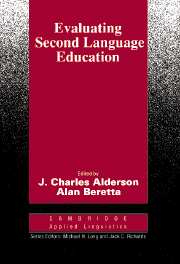Series editors' preface
Published online by Cambridge University Press: 05 October 2012
Summary
If the desire of most practitioners to professionalise language teaching were not motivation enough, increasing demands for accountability in foreign and second language education – both from those who finance such programmes and from students, the consumers – make programme evaluation of growing importance for applied linguists, administrators and language teachers. To be satisfactory, evaluations will need to be rigorous, theoretically motivated and data-based. As such, the field experiences and developing expertise among second language programme evaluators are suitable topics for inclusion in the Cambridge Applied Linguistics Series.
The more sophisticated study of second language acquisition and second language classroom processes of the 1970s and 1980s has placed second language programme evaluators in a better position to meet the demands for accountability. So has the increasing availability in masters level programmes of basic training in research methods and statistics. What is still often lacking, however, is much appreciation of the potential of qualitative methods in evaluation work, and of how useful a combination of second language research findings and quantitative and qualitative methods can often be.
Drs Alderson and Beretta are both seasoned programme evaluators and very aware of these issues. In Evaluating Second Language Education, they have provided a series of case studies which illustrate the strengths and limitations of qualitative and quantitative approaches and the frequent value of combining them. In addition, in this book, they and the other contributors have sought to document evaluation studies from the inside, in all their gory, private detail, rather than to provide more polished, but less informative, versions for the shop window.
- Type
- Chapter
- Information
- Evaluating Second Language Education , pp. viii - ixPublisher: Cambridge University PressPrint publication year: 1992



